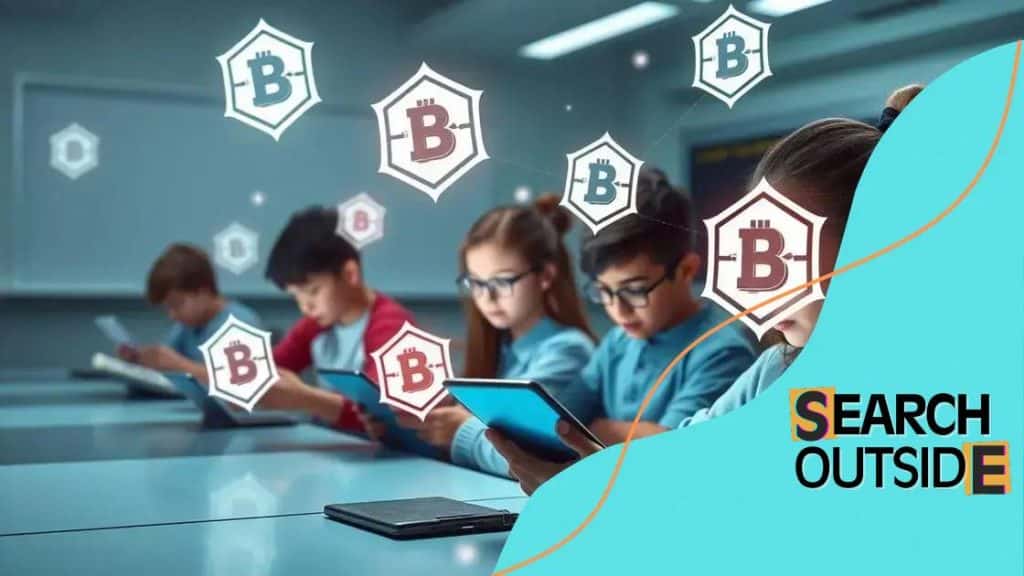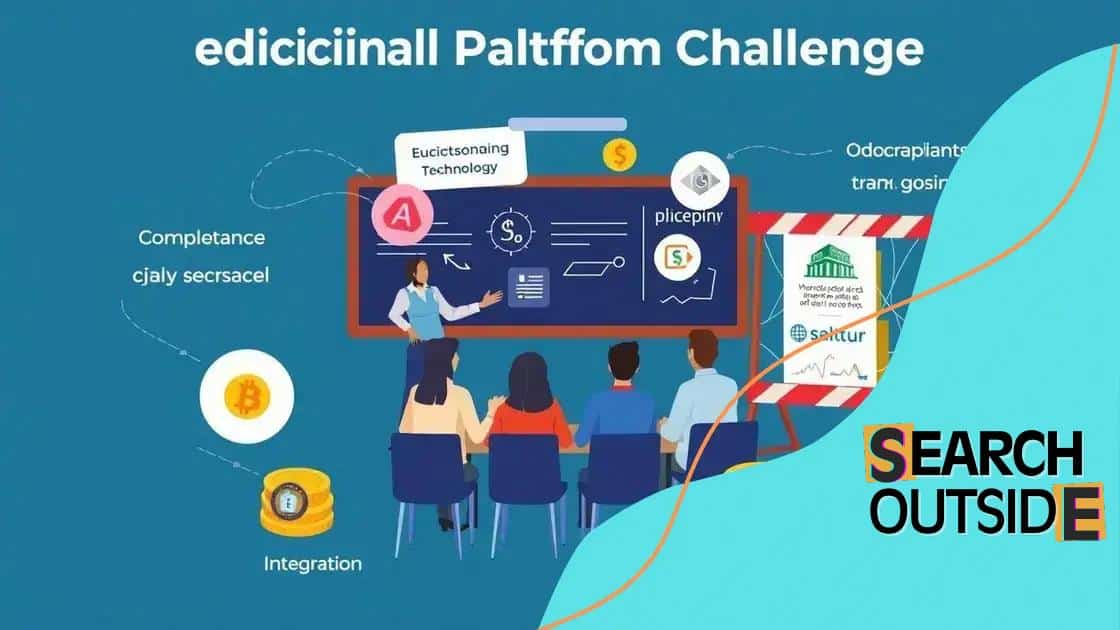How educational platforms are embracing blockchain for certification

Blockchain technology is revolutionizing how educational platforms handle certifications by ensuring secure, instant verification of credentials and giving students control over their records, thus enhancing trust and efficiency in the credentialing process.
How educational platforms are embracing blockchain for certification is a topic that sparks interest for educators and students alike. Imagine a world where credentials are instantly verifiable and secure—this isn’t just a dream, it’s becoming a reality. Let’s dive into how this technology is evolving in education.
Understanding blockchain technology in education
Understanding blockchain technology in education is crucial for grasping the future of learning and credentialing. This innovative technology promises to revolutionize how we verify achievements and track learning journeys.
At its core, blockchain is a decentralized digital ledger that records transactions across multiple computers. This ensures that records cannot be altered retroactively, creating a high level of trust and security. In education, this means that qualifications and certificates can be verified instantly, reducing fraud.
How Blockchain Works in Education
This technology operates on a peer-to-peer network, meaning there is no single point of control. Each participant, or node, maintains a copy of the entire ledger, which makes it nearly impossible to tamper with the information.
Benefits of Using Blockchain in Education
- Instant verification: Graduates can easily prove their qualifications.
- Increased security: Records are protected from tampering.
- Cost efficiency: Reduces time and costs associated with credential verification.
- Enhanced accessibility: Students have control over their credentials, allowing for easier sharing.
By utilizing smart contracts, educational institutions can automate processes like issuing diplomas. This minimizes administrative burdens and ensures that all transactions are transparent and secure. Smart contracts execute automatically when certain conditions are met, further enhancing efficiency.
In addition, utilizing blockchain technology fosters a culture of trust among students, institutions, and employers. Schools can share information without concerns about data breaches or identity theft, paving the way for more collaborative partnerships and improved educational outcomes.
As educational platforms embrace blockchain, they set a foundation for new possibilities. This technology is not just about securing records—it will lead to a transformation of the educational landscape, ensuring that qualifications are universally recognized and respected.
Benefits of blockchain for credentialing
Benefits of blockchain for credentialing are becoming increasingly evident as educational institutions and businesses explore this innovative technology. By leveraging blockchain, organizations can enhance transparency and trust in the credentialing process.
One major advantage of using blockchain is the improved security it offers. Traditional credentialing methods often leave room for fraud, but with blockchain, every record is encrypted and time-stamped. This makes it nearly impossible to alter or falsify credentials.
Instant Verification of Credentials
Blockchain technology allows for the instant verification of degrees and certifications. Employers can easily access verified records without relying on third-party verification services. This saves time and money during the hiring process.
- Quick access: Employers spend less time verifying qualifications.
- Reduced costs: Organizations save on verification fees.
- Increased trust: Verified records foster confidence in qualifications.
Another benefit is greater access to credentials for learners. With blockchain, individuals have control over their own records and can share them as needed. This empowerment can lead to better job opportunities and career advancement.
Moreover, utilizing blockchain helps in creating a more collaborative environment between educational institutions. By sharing verified credentials, schools can better understand the skills and capabilities of their graduates. This fosters partnerships that can lead to enhanced educational programs.
As organizations continue to adopt blockchain for credentialing, the landscape of education and employment is poised for a significant transformation. This technology not only streamlines processes but also creates a more secure and trustworthy system for both learners and employers.
Challenges faced by educational platforms

Challenges faced by educational platforms in adopting blockchain technology are significant and varied. While the benefits are clear, the road to implementation presents several obstacles that need to be addressed.
One of the biggest challenges is technology adaptation. Many educational institutions lack the necessary infrastructure to support blockchain solutions. Transitioning from traditional systems to blockchain can be complex and costly. It requires not only new software but also training for staff to use these systems effectively.
Regulatory and Compliance Issues
Another major hurdle is navigating regulatory compliance. Different countries have varying laws regarding privacy and data handling. Institutions must ensure that their blockchain implementations comply with these regulations to protect student data.
- Data privacy: Protecting sensitive information is a priority.
- Legal frameworks: Ensuring adherence to local laws is essential.
- Standardization: Lack of universal standards for blockchain technology complicates implementation.
Moreover, educating stakeholders about blockchain is another challenge. Many people, including educators and employers, are not familiar with how blockchain works. This lack of understanding can lead to skepticism and resistance against adopting new technologies.
Additionally, there’s the issue of interoperability. Educational platforms often use different systems and technologies, and integrating a blockchain solution that works seamlessly across platforms is a daunting task. Without proper integration, the advantages of blockchain may not be fully realized.
Funding can also be an obstacle. Many institutions operate on tight budgets and may find it difficult to allocate resources for the initial investment needed for blockchain technology. This can hinder innovation and the ability to stay competitive in an evolving educational landscape.
Real-world examples of blockchain adoption
Real-world examples of blockchain adoption in education showcase the potential of this technology to transform how institutions handle credentials and records. Various organizations are leading the way in implementing blockchain to improve security and efficiency.
One notable example is MIT, which launched a blockchain-based system to issue digital diplomas. This initiative allows graduates to share their credentials easily and securely with employers. Each diploma is stored on a blockchain, ensuring its authenticity and preventing forgery.
Open University and Digital Credentials
The Open University in the UK has also embraced blockchain technology. They use digital credentials to verify the achievements of their students. This system not only simplifies the verification process but also enhances the student’s control over their qualifications.
- Ease of access: Students can access and share their credentials anytime.
- Trust: Employers can verify the authenticity of the credentials instantly.
- Savings: Reduced administrative costs for the university.
Another example is Learning Machine, a company that partners with institutions to create blockchain credentials. Their platform allows schools to issue tamper-proof diplomas and certificates. This ensures that all records are secure and can be accessed by authorized parties only.
In addition, USC (University of Southern California) has implemented a blockchain pilot program that aims to enhance their credentialing process. The program is designed to reduce manual verification efforts, offering a faster solution for both students and employers.
These real-world examples not only illustrate the feasibility of blockchain in education but also highlight its benefits. As more institutions adopt this technology, it paves the way for innovation in how we think about credentials and student achievement.
The future of certifications with blockchain
The future of certifications with blockchain looks promising as educational institutions and employers increasingly recognize its benefits. By integrating blockchain, the credentialing process will become more efficient, secure, and reliable.
One significant change will be the use of digital certificates. These certificates will be easily verifiable and tamper-proof. As more organizations utilize blockchain technology, graduates will find their qualifications and skills recognized more widely and instantly.
Personal Control of Credentials
In the future, learners will have greater control over their credentials. With blockchain, individuals can manage their records independently, choosing when and with whom to share them. This level of control empowers students and enhances trust between them and potential employers.
- Accessibility: Individuals can access their records anytime.
- Sharing options: Control over how and where credentials are shared.
- Immediate verification: Employers can verify qualifications instantly.
Moreover, the integration of blockchain will facilitate a shift towards a more collaborative environment. Educational institutions can share credentials with one another, creating a unified system that values transparency. This collaboration can help bridge the skills gap seen in many industries today.
As employers continue to express interest in hiring candidates with verified skills, the demand for blockchain-based solutions will increase. This demand will push educational providers to innovate and adopt blockchain technology to stay competitive.
Furthermore, the rise of blockchain will lead to new forms of credentialing beyond traditional degrees. Micro-credentials, badges, and skill-based certifications will become more prevalent. This shift reflects the growing importance of acquiring specific skills in a rapidly changing job market.
FAQ – Frequently Asked Questions about Blockchain in Certifications
What is blockchain technology?
Blockchain technology is a decentralized digital ledger that securely records transactions and data in a way that is tamper-proof.
How does blockchain improve the credentialing process?
Blockchain enhances the credentialing process by providing secure, instant verification of qualifications, reducing the risk of fraud.
Can students control their own credentials with blockchain?
Yes, blockchain gives students control over their credentials, allowing them to manage and share their records as needed.
What types of credentials can be issued using blockchain?
Blockchain can issue various types of credentials, including traditional degrees, micro-credentials, and digital badges.





